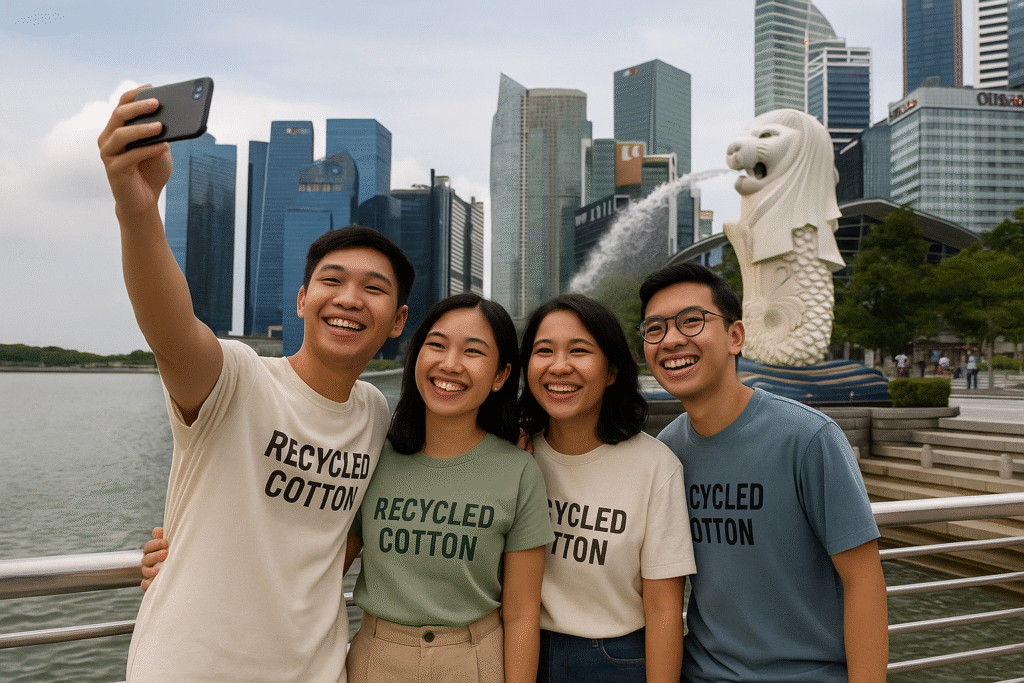As consumers in Singapore become more environmentally conscious, many are looking beyond style and aesthetics when purchasing clothing. One of the most significant shifts in the fashion landscape is the increased use of performance recycled fabrics in both activewear and everyday apparel. In particular, the debate around recycled Dri‑Fit vs recycled cotton has gained momentum among eco-minded shoppers who want to understand which fabric delivers better on performance, sustainability, and cost. Let’s take a closer look at how these two materials compare, especially in the context of Singapore’s hot and humid climate and a population that values eco-responsibility. Recycled cotton is made by reclaiming and processing pre-consumer or post-consumer cotton waste into usable yarn. This process helps divert textile waste from landfills and reduces the need for virgin cotton, which requires significant water and pesticide use. On the other hand, recycled Dri‑Fit is typically derived from recycled polyester sources, such as PET plastic bottles. The polyester is processed into fibers and engineered to have moisture-wicking properties, ideal for high-performance activities and sports. In the discussion of recycled Dri‑Fit vs recycled cotton, it’s important to understand that these fabrics are not direct substitutes. Each serves a unique purpose depending on the garment’s use, the wearer’s lifestyle, and environmental priorities. When it comes to functionality and wearability, performance recycled fabrics like recycled Dri‑Fit offer a clear advantage in activewear. The Dri‑Fit technology is specifically engineered to wick sweat away from the skin, keeping the body dry and cool — a crucial benefit for anyone participating in outdoor sports or working out in Singapore’s humid environment. The lightweight, quick-drying nature of recycled Dri‑Fit garments also helps to reduce the discomfort caused by perspiration during everyday wear. In contrast, recycled cotton retains the natural softness and breathability of traditional cotton, making it perfect for casual wear, relaxed environments, or fashion-forward pieces. However, its absorbent nature means it holds onto moisture longer than Dri‑Fit, making it less suitable for athletic use or extended wear in humid conditions. Still, for Singaporeans looking to reduce their environmental impact without sacrificing comfort, recycled cotton provides a reliable and gentle option for less physically demanding use cases. One of the most critical concerns for eco-conscious shoppers is the environmental footprint of their clothing choices. In this regard, both recycled Dri‑Fit and recycled cotton shine, albeit in different ways. Recycled cotton significantly reduces the need for water, dyes, and energy when compared to virgin cotton. The process also supports circular fashion by reintroducing waste back into the production cycle. However, performance recycled fabrics like recycled Dri‑Fit bring their own sustainability strengths. By diverting plastic waste from landfills and oceans and transforming it into functional apparel, recycled polyester contributes to reducing the overwhelming plastic pollution issue that affects Southeast Asia and the globe. Moreover, advancements in textile engineering are now making recycled Dri‑Fit fabrics increasingly biodegradable and recyclable, giving them a promising future in sustainable fashion. Choosing between recycled Dri‑Fit vs recycled cotton from a sustainability standpoint often comes down to a question of impact scale. Recycled Dri‑Fit addresses plastic pollution and long-term durability, while recycled cotton focuses on reducing textile and agricultural waste. Both contribute positively to reducing environmental harm, which is a priority for many brands and consumers in Singapore. While sustainability and performance are top priorities, cost remains a significant factor for many consumers in Singapore. Performance recycled fabrics like Dri‑Fit often involve more complex engineering and processing, which can make them slightly more expensive than recycled cotton options. However, their durability and long-lasting performance can translate to better value over time, especially for athletic use. Recycled cotton, being easier to process and closer in structure to conventional cotton, tends to be more affordable. It provides a budget-friendly entry point for those new to sustainable fashion or for shoppers looking to make incremental changes to their wardrobe without overspending. Brands that offer basic tees, everyday tops, and loungewear made with recycled cotton can keep prices competitive while delivering on comfort and environmental ethics. That said, local brands in Singapore are increasingly offering both fabric types in competitively priced collections, aiming to balance environmental consciousness with consumer affordability. This makes it easier for Singaporeans to support eco-friendly fashion without compromising on quality or function. Ultimately, the choice between recycled Dri‑Fit vs recycled cotton boils down to your lifestyle, values, and intended use. If your wardrobe needs revolve around performance, fitness, and longevity, then performance recycled fabrics like Dri‑Fit offer the moisture control and durability you require. On the other hand, if comfort, softness, and daily wear are your main goals, recycled cotton is a beautiful, natural alternative that aligns well with eco-conscious values. For Singaporeans committed to living sustainably, supporting brands that offer a mix of both materials may be the best approach. Whether you’re hitting East Coast Park for a jog or lounging at home during a rainy afternoon, making informed choices about the fabrics you wear is a powerful way to reduce your environmental footprint. As the demand for performance recycled fabrics continues to grow, expect to see innovations that blend the best features of both recycled cotton and Dri‑Fit. Fashion in Singapore is not just about looking good — it’s about feeling good and doing good for the planet. By choosing garments that feature recycled Dri‑Fit vs recycled cotton, consumers aren’t just wearing a piece of clothing; they’re making a statement about sustainability, ethics, and the future of fashion. Understanding the Fabric Basics

Performance in Daily Use
The Sustainability Factor

Cost Considerations
Making the Right Choice for You
- Home
- About Us
- Services Provided
- Heat Transfer Vinyl Roll
- Jersey Product & Tshirt Range
- Gallery
- FAQ
- Contact Us









